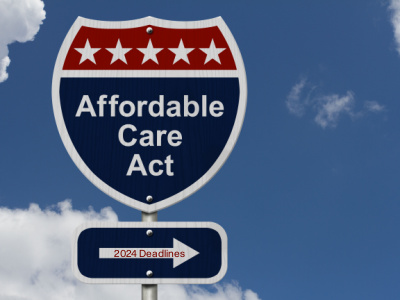Employers across the United States that have yet to act on their Affordable Care Act (ACA) filing duties are running out of time and should move swiftly.
To comply with the ACA 1095-C furnishing deadline for the 2023 tax year, employers must send forms to their full-time employees by March 1, 2024. Further, to comply with the Internal Revenue Service’s (IRS) filing deadlines, those employers filing 1095-C forms electronically have until April 1, as paper filing has been mostly phased out.
Employers that fail to comply with these deadlines face stiff penalties that can quickly escalate depending on the size of your organization. And the risk looms as large as ever, with a 2023 survey by Trusaic finding that 1 in 4 organizations are audited by the IRS for ACA non-compliance.
1095-C Form Penalties for Non-Compliance
The ACA, which went into effect 2015 tax year, requires all Applicable Large Employers (ALEs) to offer full-time employees qualifying healthcare coverage. An ALE is an employer with an average of at least 50 full-time employees.
Financial and legal consequences of late, inaccurate, or non-submission of forms are at an all-time high. Failure to comply with IRS filing deadlines for 1095-C, or furnishing incorrect forms, may incur significant penalties. The penalties have continued to increase since implementation, and the 2024 penalties are as follows:
- $60 per return if filed within 30 days of the due date.
- $120 per return if filed 31 days late through Aug. 1.
- $310 per return if filed after Aug. 1.
- $630 per return for intentional disregard.
Additionally, the penalty for failing to file accurate information is $310 for each return for which the failure occurs.
While these penalties might seem miniscule on the surface, they are all compounded based on the employer size. For example, if an ALE with 300 full-time employees disregard the 1095-C filing requirements altogether in 2024, they will be penalized $189,000—this escalates significantly when factoring in the financial liability tied to the Employer Mandate.
The Employer Mandate Penalty Risk
Under the ACA, ALE’s must offer Minimum Essential Coverage (MEC) that is affordable and meets Minimum Value (MV) to at least 95% of their workforce and their dependents.
Organizations that do not offer MEC to at least 95% of their full-time employees, and their dependents, for any month in 2024, and have at least one full-time employee receive a Premium Tax Credit (PTC) for purchasing coverage through a state or federal ACA marketplace, could be subject to 4980H(a) penalty, which is $247.50, or $2,970 annualized, per employee. The 4980H(a) penalty, often called the “hammer penalty” due to its pass-fail nature, applies across the entire workforce when the 95% threshold is not met.
Similar to the penalty for 1095-C non-compliance, the penalty seems negligible on the surface. However, if an organization in 2024 has 300 full-time employees, and one of their employees receives a PTC for 12 months, the penalty would be $801,900.
Here’s the formula: $2,970 x (300-30) = $801,900.
The 4980H(a) penalty applies across every full-time employee and affects all 300 full-time employees, minus the 30-employee exemption. This occurs even if only one employee receives a PTC.
For the 2024 tax year, the 4980H(b) penalty is $372 a month, or $4,460 per year, per employee.
Unlike the 4980H(a), the IRS issues 4980H(b) penalties on a per-violation basis. In other words, if an employee has inadequate coverage and seeks assistance from a state or federal marketplace, a penalty may be assessed.
The IRS issues a 4980H(b) penalty when an employer offers its full-time employees coverage that is either unaffordable, does not meet MV, or both. Like the 4980H(a) penalty, the organization must also have at least one employee obtain a PTC from a state or federal health exchange, as this is the trigger for the IRS assessing ACA penalties.
While the 4980H(b) penalty may have a higher potential, it is applied less frequently since it does not follow a pass/fail situation like the 4980H(a). For example, an employer with 10 full-time employees who each received a PTC for six months would incur a penalty of $22,320.
Here’s the formula: ($372 x 6) x 10 = $22,320. The 4980H(b) penalty would only apply to the 10 employees who received a PTC for the six-month timeframe.
It’s important to note that employers cannot receive both a 4980H(a) and 4980H(b) penalty for the same tax year. Thus, if an organization is found in violation of both requirements, the amount is capped at what could be assessed under 4980H(a) d. The IRS issues both 4980H(a) and 4980H(b) penalties via Letter 226J.
The Burden of Compliance
Complying with the ACA is a complex task for organizations to deal with, especially smaller companies with less of an HR and benefits infrastructure in place.
Trusaic’s research indicates that many employers find IRS reporting requirements burdensome, with nearly 70% spending more than 80 hours a year on ACA compliance activities. HR professionals in the survey cited a variety of challenges, including a lack of clarity around the rules, complex tracking requirements, complicated situations, and tight deadlines.
These factors are amplified for employers that operate in the various jurisdictions that have ACA filing requirements, including California, Massachusetts, New Jersey, Rhode Island, Washington D.C.—all of which have associated penalties for non-compliance.
Employers can successfully navigate the complexities of ACA reporting requirements by leveraging external support. Select ACA compliance service providers will utilize data quality, regulatory compliance, analytics and monthly monitoring to ensure your organization avoids costly penalties from the IRS.
With important filing and furnishing deadlines right around the corner, employers that outsource their ACA compliance efforts are removing the burden of compliance and positioning themselves for a stress-free tax season.
Maxfield Marquardt is Senior Counsel/Director of Regulatory Affairs for Trusaic, a workplace equity technology company committed to advancing social good by helping organizations achieve pay equity, foster a more diverse and inclusive workforce, assist economically disadvantaged individuals with finding work, and ensure employee access to affordable healthcare.

